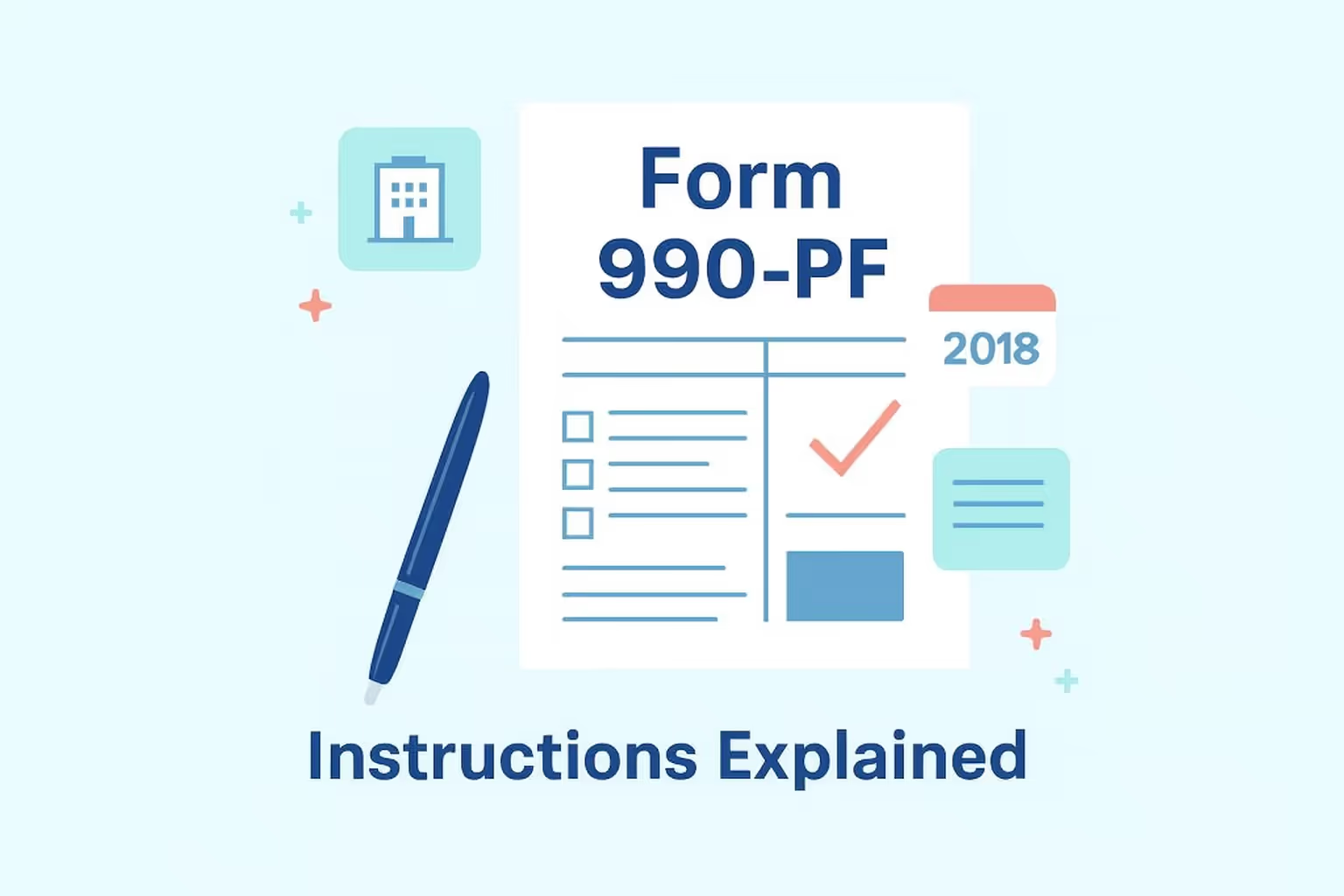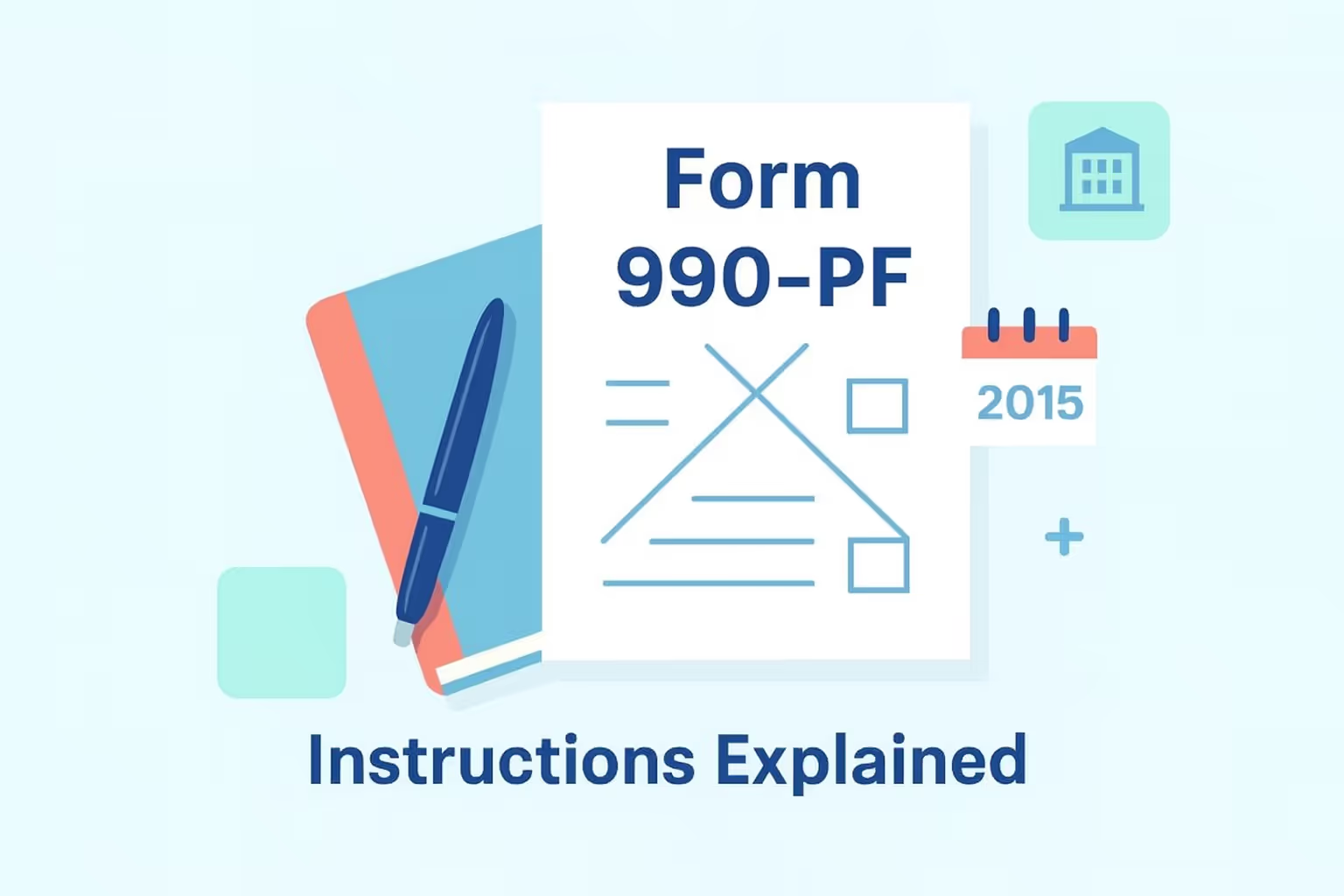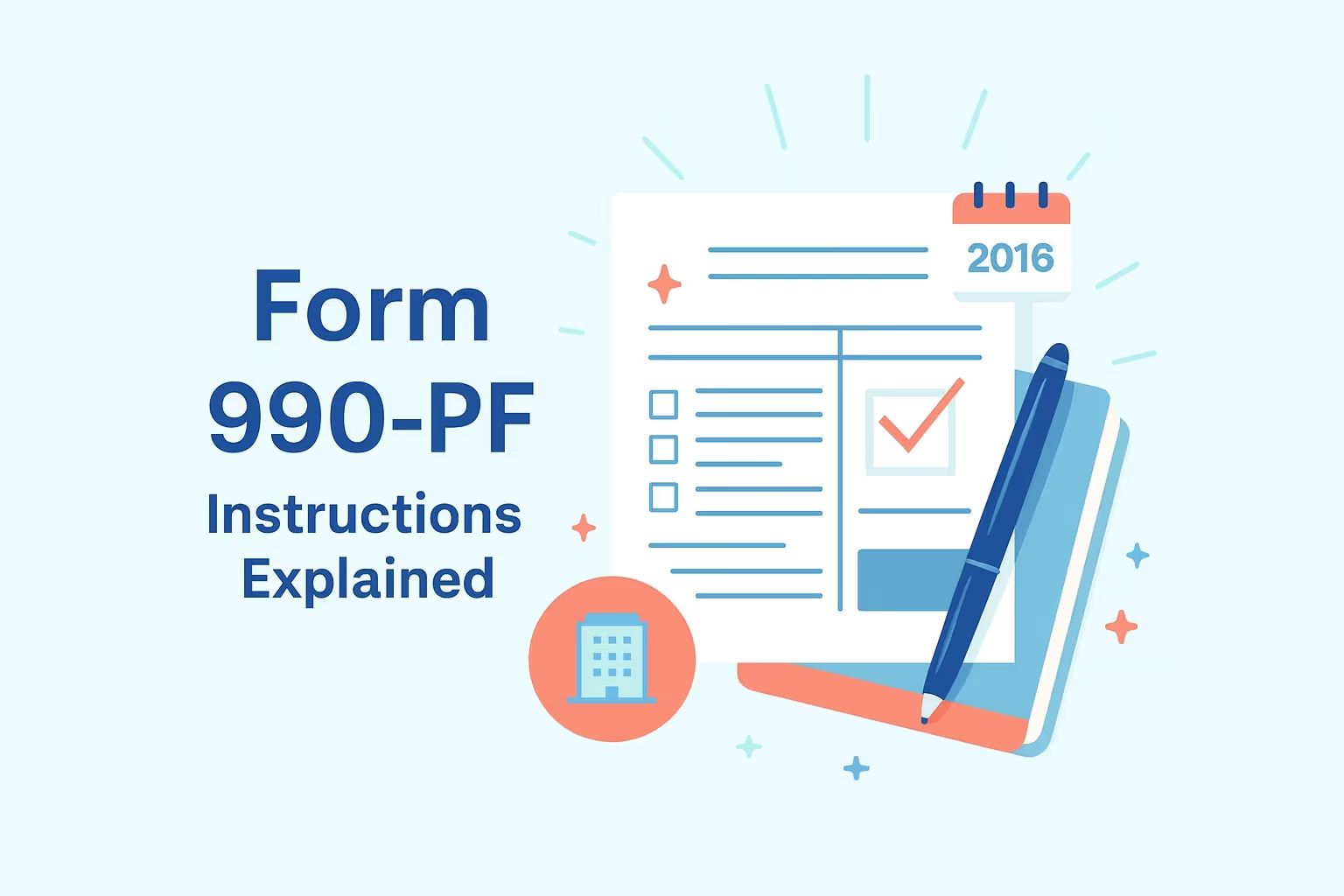Private Foundation Tax Filing: Form 990-PF 2018 Instructions

Private foundations are required to file Form 990-PF annually with the Internal Revenue Service to maintain compliance. This return explains how the foundation is organized and provides information about charitable contributions, grants, and deductible distributions. For individuals responsible for reporting, understanding this process is essential because it connects financial activities to the foundation’s legal obligations. Many readers may find this subject overwhelming, so this guide explains it in clear, structured language.
The filing requirement is more than a technical step. It ensures transparency and accountability, making sure that cash and other resources support approved charitable purposes. Meeting the due date is also crucial since delays can result in consequences that affect both the foundation and the communities it serves. Through accurate information reporting, foundations remain responsible to the public while continuing to provide benefits to schools, hospitals, and child-focused programs.
This article focuses on the 2018 Form 990-PF and the key issues involved in completing it. You will learn who must file, what changes were applied in 2018, and how to follow the process from start to end. Additional sections will explain excise tax rules, payment methods, schedules, and practical guidance for first-time filers.
Overview of Private Foundations and Who Must File
Private foundations operate as charitable organizations established through substantial contributions, typically from a single donor, family, or corporation. These organizations distribute grants, direct charitable contributions to schools and hospitals, and provide benefits that support individuals and communities. To remain deductible and compliant, a foundation must be appropriately organized and file Form 990-PF annually. This filing process ensures that accurate information is shared and that foundations are fulfilling their obligations.
Private foundations differ from public charities in structure and funding. Public charities, such as hospitals or universities, rely on community-wide support, while private foundations rely on fewer funding sources. This narrower funding base means each account, grant, and cash distribution is more closely reviewed. Annual reporting demonstrates that a foundation is responsible for its charitable process and transparent in providing benefits to the public. Filing also affirms the value of assistance offered through grants and deductible programs.
The responsibility to file Form 990-PF applies to multiple entities. Exempt private foundations are required to file an annual report to document their activities and fulfill excise tax requirements. Taxable private foundations must also submit the form, including those engaged in investment income or business activities, which are subject to review.
Charitable trusts organized under section 4947(a)(1) are also required to file, along with organizations that present themselves as private foundations while their exempt status applications are pending. As explained in the 2018 IRS Form 990-PF Instructions, foundations undergoing termination elections under Section 507(b) must also comply with the filing requirement.
Entities Required to File Form 990-PF
- Exempt private foundations: These are organizations that maintain exempt status and report grants, contributions, and deductible activities.
- Taxable private foundations: These are entities that are required to report their accounts and remain subject to excise tax rules.
- Charitable trusts under section 4947(a)(1): These are trusts organized for charitable purposes that must file under private foundation regulations.
- Organizations with pending exempt status: These are groups that are still under review and present themselves as private foundations.
- Foundations electing termination under Section 507(b): These are entities that wind down their operations while remaining responsible for compliance with applicable laws and regulations.
Failing to file for three consecutive years results in the automatic loss of exempt status. Meeting each due date ensures that foundations remain in good standing, continue making grants, and maintain public trust in their organized operations.
Key Changes: 2018 Tax Year
The Tax Cuts and Jobs Act introduced significant revisions that affected how private foundations filed Form 990-PF for the 2018 tax year. These changes influenced how organizations reported investment income, charitable contributions, and deductible benefits. Each update introduced requirements affecting accounts, grants, and the individuals responsible for compliance. Adapting to these revisions helped foundations remain organized, meet their deadlines, and continue to assist schools, hospitals, and child-focused programs.
Major 2018 Updates
- Excise tax on executive compensation: A new rule applied an excise tax to foundations paying more than $1 million in annual salary to a covered employee. It also extended to excess parachute payments, requiring organizations to review contracts and carefully assess cash-related benefits.
- Exception for business holdings: Section 4943(g) created an exception from the excess business holdings tax for businesses wholly owned and independently operated by private foundations. This adjustment provided flexibility while maintaining oversight.
- Global Intangible Low-Taxed Income (GILTI): Foundations with foreign corporation interests were required to include GILTI in unrelated business taxable income. This obligation expanded reporting to international accounts and required additional attention to recordkeeping.
- Section 965(a) income inclusion: Repatriated income from certain foreign corporations must be reported under Section 965(a). This rule affected taxable accounts and required completion of Form 965.
- Unrelated business taxable income from fringe benefits: Disallowed benefits, such as parking or transportation, became part of UBTI reporting. Foundations had to determine whether these costs changed their overall income calculations and adjust filings accordingly.
Each change required careful evaluation of charitable contributions, investment income, and deductible grants. Foundations that remained attentive to these requirements avoided errors and upheld their responsibilities. As clarified in the 2018 Form 990-PF instructions PDF, meeting these obligations reinforced accountability and transparency. Completing the process with accuracy strengthened public confidence, ensuring that foundations remained responsible for delivering benefits through an organized and compliant framework.
Filing Requirements and Due Date
Private foundations are required to follow a consistent filing schedule to remain compliant with federal law. Form 990-PF provides the Internal Revenue Service with information on charitable contributions, grants, and investment income. Each filing demonstrates that the organization remains responsible for its accounts and continues to provide benefits to schools, hospitals, and individuals. Meeting the filing deadline is a crucial requirement, as late submissions can disrupt compliance and create additional challenges.
For calendar-year foundations, the filing due date falls on May 15 of the year following the close of the tax year. For fiscal-year organizations, the deadline is the 15th day of the fifth month after the foundation’s year-end. Extensions are available through Form 8868, which grants six additional months to file. An extension delays only the reporting, not the payment of excise tax or other obligations. Organizations that fail to prepare on time risk jeopardizing their exempt status.
Filing Timeline and Considerations
- Calendar year filers: These returns are due on May 15 for activities reported from January 1 through December 31.
- Fiscal year filers: File the return on the 15th day of the fifth month following the end of the fiscal year.
- Extension option: File Form 8868 to request a six-month extension.
- Payment requirements: Cash or account obligations remain due on the original deadline, even if granted an extension.
- Proof of filing: Using certified mail or electronic submission provides evidence that the foundation fulfilled its responsibility.
Filing requirements include attaching all relevant schedules, reporting deductible contributions, and disclosing any grants made during the year. Each foundation must ensure that its organized records align with the information presented on the form. The filing process demonstrates transparency in how funds are managed and how benefits are distributed to the public. Meeting the deadline maintains compliance and confirms the foundation’s commitment to fulfilling its obligations.
Timely filing reinforces private foundations' credibility and ability to provide support across multiple sectors. By remaining diligent with deadlines and accurate reporting, organizations can preserve their exempt status and continue to offer assistance that aligns with their charitable mission. The due date structure gives foundations a clear framework to operate, ensuring consistency in both financial accountability and public trust.
Step-by-Step Process to Complete Form 990-PF
Completing Form 990-PF requires careful organization, accurate information, and a structured process. Each step ensures that charitable contributions, grants, investment income, and deductible activities are adequately documented. Private foundations must take responsibility for every account, line item, and attachment to demonstrate transparency and compliance with federal requirements. The walkthrough below provides a systematic way to complete the filing while minimizing errors.
Step 1: Gather Essential Records
Start by collecting all documents related to the tax year. This includes cash account statements, records of charitable contributions, detailed grant information, and meeting notes from board meetings. Preparing these materials ensures that every section of the form can be completed accurately and in a timely manner.
Step 2: Complete the Header Information
Enter the foundation’s name, address, and Employer Identification Number. Identify the tax year dates and indicate whether the filing is an initial, final, or amended return. Completing this section carefully helps prevent filing errors and ensures proper identification of the foundation.
Step 3: Analyze Revenue and Expenses (Part I)
Report all sources of revenue, including charitable contributions, interest, dividends, rents, and capital gains. Document all expenses, including employee salaries, professional fees, and grant payments. Each line must reflect accurate information to provide a clear financial picture of how the foundation’s resources were used.
Step 4: Prepare Balance Sheets (Part II)
Record beginning and ending values for assets, liabilities, and net assets. Use fair market value rather than book value unless specifically required otherwise. This section enables the IRS to assess the foundation’s financial stability and accountability in managing its resources.
Step 5: Document Changes in Net Assets (Part III)
Outline increases or decreases in net assets during the year. This includes gains, losses, or transfers that affect the foundation’s overall financial position. Providing this information ensures compliance and demonstrates how resources are being utilized for charitable purposes.
Step 6: Capital Gains and Excise Tax Calculations (Part IV and Part V)
Report gains and losses from the sale of securities or property. If applicable, complete the section on reduced excise tax rates for foundations that qualify. These calculations demonstrate how investment income affects the foundation’s financial operations.
Step 7: Calculate Minimum Distribution Requirements (Parts X–XIII)
Determine the minimum investment return, distributable amount, qualifying distributions, and any undistributed income. These figures confirm that the foundation is meeting its obligation to provide grants and charitable support. Fulfilling this requirement demonstrates ongoing compliance and benefits to the public.
Step 8: Attach Required Schedules and Statements
Include Schedule B if any individual contributed more than $5,000 during the year. Attach other required schedules, such as Form 4720 for excise tax on certain transactions or Form 990-T for unrelated business taxable income. These attachments provide additional context and ensure complete reporting.
Step 9: Review, Sign, and Submit
Conduct a thorough review to confirm accuracy across all sections. Verify account numbers, grant totals, and deductible contributions. Once confirmed, sign the form, date it, and submit electronically or by mail before the due date. Maintain copies for organizational records and for future comparison.
Completing Form 990-PF is a demanding process that requires attention to detail and accountability. Following each step ensures that private foundations remain compliant, transparent, and organized in their reporting. By preparing carefully and documenting all required information, organizations strengthen their ability to provide ongoing charitable benefits and retain public trust.
Excise Tax and Investment Income
Private foundations must calculate excise tax on their net investment income each year when filing Form 990-PF. This tax applies to revenue generated from dividends, interest, rents, and capital gains. Understanding how these amounts are calculated is critical because the results determine whether a foundation pays the standard rate or qualifies for a reduced percentage. Foundations that remain diligent in their reporting demonstrate compliance and preserve their ability to provide charitable contributions and grants.
Standard and Reduced Excise Tax Rates
Most private foundations are subject to a 2% excise tax on their net investment income. Foundations may qualify for a reduced rate of 1 percent if they distribute a higher percentage of their income through deductible grants and charitable distributions. To claim the reduced rate, organizations must meet specific thresholds based on their activity in prior years. Demonstrating these results requires accurate records of all cash and account activity tied to charitable purposes.
Reporting Investment Income
Foundations must carefully report income from securities, savings accounts, and property. Each source should be recorded in the section of Form 990-PF designated for investment reporting. Net investment income includes gains from the sale of property or securities, minus related expenses. Deductible costs, such as fees paid to investment advisors, can reduce the amount subject to excise tax. Maintaining clear documentation ensures accuracy and helps foundations compare annual figures effectively.
Impact on Compliance
Excise tax reporting does more than calculate liability. It establishes how a foundation manages resources and fulfills its obligations to distribute benefits to the public. Inaccurate excise tax calculations can affect compliance and weaken public trust. Organized reporting provides evidence that the foundation is responsible for managing both its investments and the grants it offers for assistance.
Managing excise tax and investment income requires a careful balance of accurate accounting and thoughtful planning. When foundations maintain precise records, they protect their exempt status, ensure that their charitable contributions remain deductible, and reinforce their role in supporting schools, hospitals, and community programs. By handling this process responsibly, private foundations strengthen confidence in their operations and preserve their ability to continue their charitable mission.
Payment Methods and Obligations
Private foundations often owe excise taxes or other required payments when filing Form 990-PF. Meeting these obligations on time reinforces compliance and demonstrates accountability. Payment methods vary, allowing organizations to select the process that best suits their accounts and filing structure. Each option requires accuracy to ensure the payment is correctly credited to the correct tax year.
Electronic Payment Options
- Electronic Federal Tax Payment System (EFTPS): Individuals can schedule payments online through this system, which offers secure transactions and direct access to their accounts.
- Online banking: Many financial institutions allow direct transfers to the Treasury, which reduces processing delays and streamlines the payment process.
- Credit or debit card: Payments can be made electronically, and a processing fee will be applied to the transaction.
- IRS Direct Pay: This option enables taxes to be remitted directly from a checking or savings account, incurring no additional costs.
Paper-Based Payment Options
- Check or money order: Payments must be made payable to the ‘United States Treasury’ and must include the foundation’s Employer Identification Number.
. - Attachment with return: Checks may be submitted along with the paper Form 990-PF to the designated IRS mailing address.
- Trackable mail service: Certified or priority mail provides proof of timely submission for paper payments.
Timing and Responsibility
- Original due date requirement: Payments must be submitted by the filing deadline, even if an extension for the return is granted.
- Accurate account labeling: Each payment must clearly reference the foundation’s name, identification number, and tax year.
- Late payment consequences: Interest and charges will accrue if obligations are not fulfilled by the specified date.
Selecting the correct payment method allows private foundations to remain compliant while minimizing delays. Consistent attention to deadlines and account accuracy ensures that required amounts are recorded correctly. By fulfilling their obligations promptly, foundations maintain trust, preserve their tax-deductible activities, and continue to offer charitable contributions that benefit schools, hospitals, and community programs.
Required Schedules and Attachments
Completing Form 990-PF involves more than reporting income and expenses. Private foundations must also include specific schedules and attachments that provide a detailed view of their activities. These additions ensure transparency, verify compliance with federal rules, and confirm that the foundation is fulfilling its responsibilities through charitable contributions, grants, and organized reporting.
Action List of Key Requirements
- Schedule B – Schedule of Contributors
List each contributor who gave $5,000 or more during the year. Include names, addresses, and contribution amounts. If no contributor meets the threshold, check the appropriate box on the return. - Form 4720 – Excise Taxes on Prohibited Activities
Submit this form to request a six-month extension for filing. This extension delays the reporting process, but all payments remain due by the original deadline. - Form 990-T – Unrelated Business Income Reporting
Complete this form if the foundation generated $1,000 or more in unrelated business income. It includes cases where investment income or fringe benefits may affect taxable amounts. - Form 8868 – Extension Request
Submit this form to request a six-month extension for filing. While it delays the reporting process, all payments remain due by the original deadline. - Board Member and Officer Lists
Attach a complete roster of officers, directors, and trustees. Include names, titles, and responsibilities to confirm that the foundation is organized correctly. - Grant and Contribution Statements
Provide detailed information about each grant, including recipients, amounts, and purposes. These records show how charitable contributions are distributed to schools, hospitals, and community programs. - Supporting Documentation for Reduced Excise Tax Rates
If applying for the reduced 1 percent excise tax, attach documentation of distributions that qualify under federal standards. This evidence ensures eligibility for the lower rate.
Including accurate schedules and attachments reinforces public trust and demonstrates that foundations are responsible stewards of their resources. Each addition plays a role in verifying compliance, protecting exempt status, and showing that benefits reach their intended place.
Penalties, Compliance, and First-Time Filers
Private foundations must remain vigilant about compliance to maintain their exempt status and ability to provide charitable contributions. Filing Form 990-PF accurately and on time ensures that accounts are correctly documented and that individuals responsible for reporting demonstrate accountability.
When deadlines are missed or filings are incomplete, consequences affect both the foundation and the public programs it supports. First-time filers face unique challenges, as they must quickly learn reporting standards and organize their processes to meet all requirements.
The following table highlights the differences between filing issues, compliance responsibilities, and considerations for first-time filers. This comparison highlights the risks of missed deadlines, the importance of accurate record-keeping, and the support that new organizations may require.
Filing Deadlines
- Compliance Requirements: File Form 990-PF by May 15 for calendar-year foundations, or by the 15th day of the fifth month for fiscal-year filers.
- Risks of Noncompliance: Failure to file for three consecutive years results in automatic loss of tax-exempt status, creating financial strain on charitable work.
- Considerations for First-Time Filers: Mark deadlines well in advance, and consider using certified mail or e-file to have proof of timely submission.
Accuracy of Information
- Compliance Requirements: Report all grants, charitable contributions, and investment income in detail.
- Risks of Noncompliance: Errors, miscalculations, or omissions may lead to higher excise tax and even IRS audits.
- Considerations for First-Time Filers: Keep organized records, review prior filings if available, or seek professional assistance to ensure accuracy.
Required Schedules
- Compliance Requirements: Attach Schedule B, Form 4720, and other schedules tied to specific activities.
- Risks of Noncompliance: Missing schedules can delay IRS processing and may affect the deductible status of grants made by the foundation.
- Considerations for First-Time Filers: Review all filing requirements carefully to confirm all necessary attachments are included.
Excise Tax Reporting
- Compliance Requirements: Calculate net investment income and apply the correct excise tax rate.
- Risks of Noncompliance: Incorrect reporting could create additional tax liabilities or compliance issues.
- Considerations for First-Time Filers: Learn how to apply the reduced 1% rate if distribution requirements are met.
Recordkeeping
- Compliance Requirements: Maintain detailed accounts, grant records, and a list of board members.
- Risks of Noncompliance: Poor documentation can damage the foundation’s credibility and raise compliance red flags.
- Considerations for First-Time Filers: Establish strong recordkeeping systems early to make future filings easier.
Compliance ensures that foundations continue providing benefits to schools, hospitals, and individuals in need. First-time filers who approach the process methodically gain confidence and set strong standards for future filings. Staying organized, meeting due dates, and maintaining accurate records not only strengthen public trust but also protect the foundation’s mission.
Frequently Asked Questions
What is Form 990-PF, and who must file it?
Form 990-PF is the annual return required for private foundations under federal income tax law. It reports financial activities, grants, and compliance with distribution requirements. Any type of private foundation, whether exempt or taxable, must file its return each year. This includes charitable trusts treated as private foundations. Filing demonstrates transparency, keeps the organization open to public review, and ensures accountability in the distribution of funds to community programs.
When is the due date for filing Form 990-PF?
The due date depends on whether the foundation uses a calendar or a fiscal year. Calendar-year organizations must file by May 15, while fiscal-year filers submit on the 15th day of the fifth month following the end of the fiscal year. Extensions can be requested, but income tax payments remain due by the original deadline. Submitting on time confirms compliance and enables charitable work to continue uninterrupted, allowing for the fulfillment of scheduled grants and obligations.
Are charitable contributions to private foundations deductible?
Charitable contributions to private foundations are deductible, although the limits differ from those for gifts to public charities. Individuals can deduct cash or property donations, subject to income tax restrictions that vary based on the donor's type and filing status. Deductibility helps encourage philanthropic support, but accurate reporting is necessary to claim these benefits. Donors and foundations remain responsible for ensuring that their contributions align with federal requirements and the documented purposes of the foundation.
How are grants reported on Form 990-PF?
Grants must be listed with recipient names, amounts, and purposes. This ensures that charitable distributions remain transparent and demonstrate proper use of resources. Whether directed to schools, hospitals, or community programs, each type of grant requires detailed reporting. Additionally, clear records support the deductibility of contributions. These disclosures strengthen accountability and confirm that foundations are fulfilling their mission while providing benefits to individuals and organizations in need.
How does the locked padlock icon relate to e-filing?
When filing electronically, the locked padlock icon on IRS-approved software confirms that sensitive data is encrypted. This symbol reassures filers that their accounts, income tax information, and grants remain secure during submission. Electronic filing offers efficiency while protecting sensitive information. Using the correct provider ensures that returns are transmitted safely, preserving compliance and maintaining confidence in the filing process for both foundations and individuals responsible for submission.
What happens if a foundation has no activity?
Foundations must still file Form 990-PF even during dormant years with no contributions or grants. The return must remain open with zeros recorded where applicable. This ensures that compliance is maintained and that tax-exempt status is not revoked after three consecutive non-filings. Additionally, the form must be signed and dated correctly. Filing during inactive periods demonstrates ongoing accountability, confirming that organizations remain organized and responsible when there is a lack of activity.
Where can filers find the most up-to-date information about Form 990-PF?
Filers should consult official IRS resources, which are regularly reviewed and updated on each page. The “page last reviewed” date confirms when the IRS verified accuracy. These updates ensure that income tax requirements, due dates, and grant reporting deadlines remain up to date. References at the bottom of IRS pages provide context about revisions. Relying on updated IRS publications keeps private foundations aligned with evolving rules and ensures continued compliance.



























